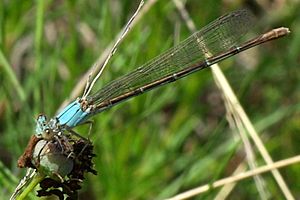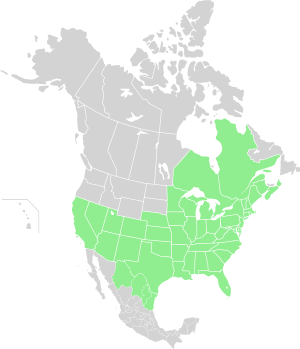Powdered dancer facts for kids
Quick facts for kids Powdered dancer |
|
|---|---|
 |
|
| Conservation status | |
| Scientific classification | |
| Kingdom: | |
| Phylum: | |
| Class: | |
| Order: | |
| Suborder: | |
| Family: | |
| Genus: |
Argia
|
| Species: |
A. moesta
|
| Binomial name | |
| Argia moesta (Hagen, 1861)
|
|
 |
|
| Range of A. moesta | |
The powdered dancer (Argia moesta) is a type of damselfly. It belongs to the Coenagrionidae family, which is a group of small, often colorful damselflies. This amazing insect lives naturally in North America. You might even spot them flying around all year long in some warmer parts of their home range.
Contents
What is a Damselfly?
Damselflies are fascinating insects that are often confused with dragonflies. Both are part of a group called Odonata. However, damselflies are usually smaller and more delicate. When they rest, most damselflies hold their wings together over their back, while dragonflies hold their wings out flat.
Damselflies, like the powdered dancer, have long, slender bodies and two pairs of clear wings. They also have large eyes that help them see very well. These insects are important predators in their habitats, helping to control populations of smaller insects.
Where Powdered Dancers Live
The powdered dancer damselfly is found across a wide area of North America. They prefer to live near slow-moving water, like streams, rivers, and ponds. You can often find them flying close to the water's surface or resting on plants nearby.
They need clean water to lay their eggs and for their young to grow. Their presence can sometimes be a sign that the water environment is healthy.
What Powdered Dancers Look Like
The powdered dancer damselfly gets its name from its unique appearance. Male powdered dancers often look like they are covered in a light, powdery substance. This powdery look is called pruinosity. It's a natural coating that develops as the damselfly gets older.
- Young males (called tenerals) might be a different color, often brownish.
- Mature males develop a powdery blue or grayish coating. Older males can even look more ash-white than blue.
Females of this species can come in different colors. Some females are brown, while others might have a blue tint, similar to the males. Both males and females have clear wings.
Life Cycle of a Damselfly
Like all insects, the powdered dancer damselfly goes through a life cycle with different stages.
Eggs
Female damselflies lay their eggs in or near water. They often place them inside plant stems or on underwater plants.
Nymphs
Once the eggs hatch, tiny young damselflies called nymphs emerge. These nymphs live underwater. They are skilled hunters, using a special lower lip that shoots out to catch small aquatic insects. Nymphs will molt (shed their skin) several times as they grow.
Adults
When a nymph is ready to become an adult, it crawls out of the water onto a plant stem or rock. Its skin then splits open, and the adult damselfly emerges. At first, the adult is soft and pale, but it soon hardens and develops its full colors. Adult damselflies spend their time flying, hunting, and finding a mate to start the cycle all over again.
Why "Powdered Dancer"?
The common name, "powdered dancer," describes the male damselfly perfectly. The "powdered" part refers to the powdery blue or grayish coating that covers older males. The "dancer" part likely refers to their graceful, darting flight as they move around.
The scientific name, moesta, means "sorrowful" in Latin. Some people think this name might refer to old customs where people would dust themselves with ashes to show sadness. This could connect to the ash-white look of very old male powdered dancers.
Images for kids









